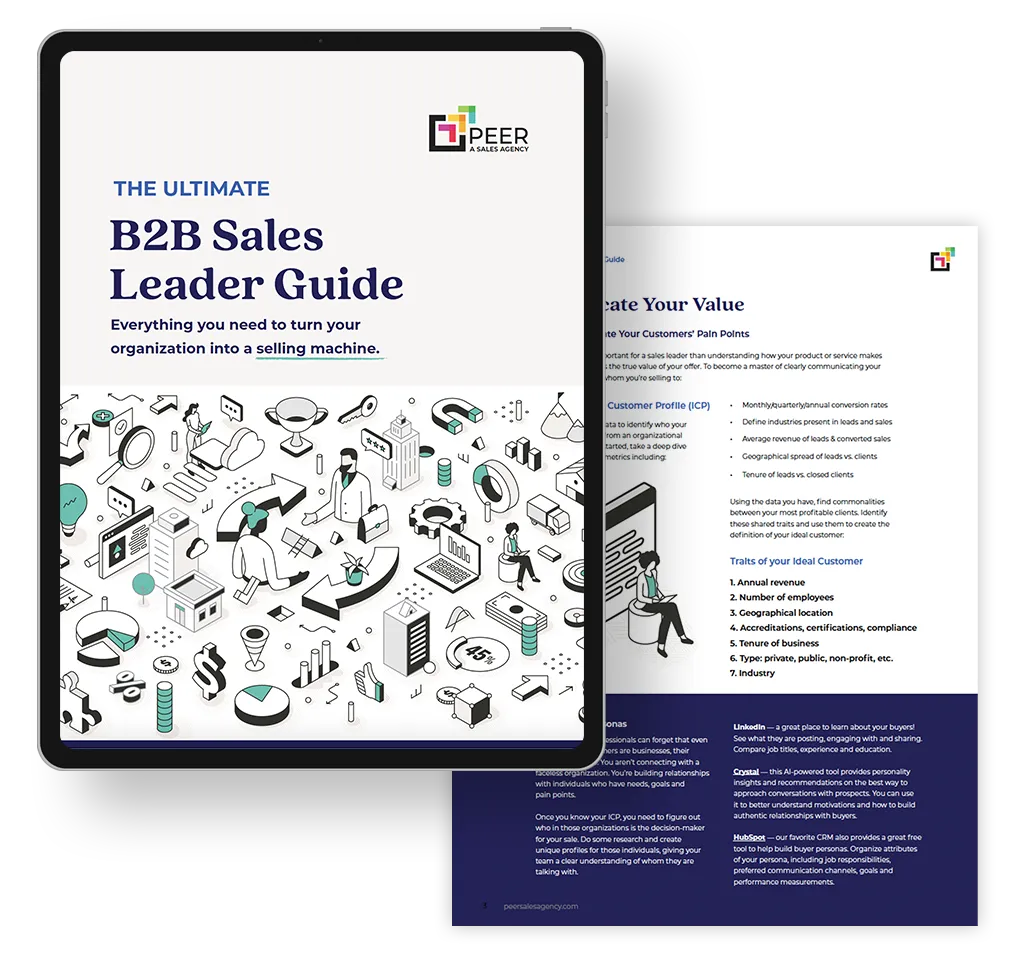How to Follow Up with Leads: A Strategy
You’ve created an effective marketing campaign regularly generating warm leads for your sales team. These qualified leads aren’t the final goal. In fact, they are just the start of a buyer’s journey. Now’s the time to start closing a sale – but first, you’ll need to improve lead follow-up basics.
In a highly competitive business landscape, effectively following up with potential customers is a crucial step in the sales process. A well-executed follow-up strategy enhances your chances of converting qualified leads into paying customers. Whether you’re a sales team or a small business owner, understanding best practices for lead follow-up can significantly improve your outcomes.
A Strong Lead Follow-up Strategy with Sales Leads Includes Several Key Elements:
1. Timeliness is key
2. Personalize your messages
3. Prioritize promising leads
4. Use a multichannel approach
5. Be persistent
6. Provide valuable content
7. Overcome objections
8. Monitor and optimize
By building a strategy that uses these best practices, you can significantly improve lead follow up on your team, and boost your chances of successful lead conversion. Let’s dive in and take a closer look at each of these follow-up elements.
Promptness Matters
Time is of the essence, especially when it comes to lead follow-up. The sooner you reach out to a qualified lead, the higher your chances of success. Research shows that 50% of buyers choose the vendor that responds first. Promptness is key to effective lead follow-up.
When you receive a lead’s information, make it a priority to respond as soon as possible. According to data from Dr. James Oldroyd in 2007, “the odds of the lead entering the sales process, or becoming qualified, are 21 times greater when contacted within five minutes versus 30 minutes after the lead was submitted.”
Why does acting fast lead to such high conversion? Because your lead is still looking for a solution. They are in the act of research and information gathering. Their attention has not moved on to another task. You’ll strike while the iron is hot. Get them while their interest is fresh and they have your business top of mind.
To ensure prompt follow-up, have a system in place that allows you to respond quickly and efficiently to new leads. This may involve setting up email templates or creating standard phone scripts. Your sales reps can easily personalize and send them out with just a few clicks. Utilize customer relationship management (CRM) tools to track and manage your leads, so nothing falls through the cracks.
Remember, busy people appreciate promptness. A fast-paced world bombards everyone with information and demands on their time. By being prompt and respecting your leads’ time, you demonstrate professionalism and create a positive customer experience.
Personalization and Relevance
Personalization and relevance are two key elements in effective lead follow-up. It is crucial to tailor your follow-up approach to each individual lead. This will help you stand out from the crowd.
One way to personalize your follow-up is using automation tools in your CRM system. Build a response with personalization tokens to create a customized message. Information like name, business name, and even the name of the asset they downloaded are easy ways to build familiarity.
Relevance is equally important in effective lead follow-up. It’s not enough to simply reach out promptly; your message must also be relevant and valuable to the lead. Build on the information they originally interacted with. Share relevant content such as blog posts, white papers, or case studies. Make sure you’re staying in the same topic vertical to deepen their understanding.
To ensure relevance, it is essential to constantly nurture your leads throughout the sales process. This means regularly checking in, providing updates, and offering new insights or solutions that align with their evolving needs. Stay engaged and invest in their success.
Personalization and relevance are unskippable items if you want to improve lead follow-up. By tailoring your messages, you increase your chances of converting leads into satisfied customers. Remember, every interaction is an opportunity to build a strong business relationship, so make each follow-up count.
Lead Scoring and Prioritization
Not all leads are equal. It’s essential to prioritize and focus your sales efforts on the ones that are most likely to convert into paying customers. This is where lead scoring and prioritization come into play.
Lead scoring is assigning a numerical value to each lead based on their characteristics and behavior. This helps you identify the most qualified and promising prospects. By evaluating specific criteria, you can prioritize your follow-up efforts and allocate your resources effectively. This helps you improve lead follow-up for your team by allowing your sales reps to focus on the hottest leads first.
Lead Scoring Best Practices
- Define your ideal customer profile. Before you can effectively score and prioritize leads, it’s crucial to have a clear understanding of your ideal customer. Identify the key identifiers that align with your product or service. This will serve as the foundation for your lead scoring model.
- Align your buyer persona. Once you have your ICP, you can identify who in the organization is your buyer. Think about the people your sales team interacts with the most. Do they have similar titles and roles within the organization? Do a little digging on the people who buy your product and create a persona that links their similarities.
- Determine your scoring criteria. Once you have defined your ideal customer profile, establish the criteria to assign scores to each lead. Consider factors such as industry, company size, job title, website activity, email engagement, and social media interactions. Look at the behaviors of the customers you’d want 10 more of. Now align your scoring criteria to identify more of them.
- Assign weights to scoring criteria. Not all criteria carry the same level of importance in predicting a lead’s likelihood to convert. Assign weights or points to each scoring criterion based on its relative value. For example, a lead from an executive-level decision-maker should receive a higher score than an employee without decision-making authority.
- Establish scoring thresholds. Determine the score threshold that qualifies a lead as “hot” or highly prioritized. This threshold should align with your sales team’s capacity and the number of leads they can effectively manage.
- Continuously refine and update your scoring model. Lead scoring is not a set-it-and-forget-it process. Regularly review and analyze the effectiveness of your scoring criteria and model.
The Benefits of Lead Scoring
By implementing a lead scoring and prioritization system, you can focus your sales efforts on the highest quality leads. This will improve the efficiency of your follow-up process. Here are some additional benefits:
- Optimized time and resource allocation. Instead of wasting time on leads that are unlikely to convert, your sales reps can concentrate their efforts on quality leads. This translates into increased productivity and improved sales outcomes.
- Higher conversion rates. By prioritizing leads that have demonstrated a higher level of interest, you increase the likelihood of converting them into paying customers. Your sales team can tailor their follow-up approach for each priority segment, maximizing the chances of success.
- Improved customer experience. With lead scoring and prioritization, you can ensure that your sales team provides timely and personalized follow-up to hot leads. This level of attentiveness contributes to a positive customer experience, fostering trust and building stronger relationships.
- Enhanced collaboration between marketing and sales teams. Lead scoring facilitates the alignment between marketing and sales by providing a clear and objective way to track lead quality. It helps bridge the gap between the two departments and encourages better communication and cooperation.
Lead scoring and prioritization are essential steps in an effective sales follow-up strategy. By accurately assessing the quality and potential of your leads, you can optimize your resources and increase conversion rates. Implementing a robust lead scoring and prioritization system also strengthens the alignment between marketing and sales, driving success for your business.
Use a Multichannel Approach to Improve Lead Follow-up
For improved lead follow-up, using a multichannel approach can significantly enhance your chances of success. Don’t rely on just one communication method, such as a follow-up email or phone call. Incorporate various channels to reach your leads through their preferred means of communication. This not only increases the likelihood of making initial contact but also enhances the overall customer experience.
Here are some best practices for implementing a multichannel approach to your qualified lead follow-up strategy:
- Understand your leads’ communication preferences. To effectively reach your leads through different channels, it’s important to first understand their communication preferences. Some leads might prefer email, while others may favor phone calls or even social media messaging.
- Leverage email marketing. Email remains one of the most commonly used communication channels for lead follow-up. It allows you to provide valuable content, updates, and personalized messages directly to your leads’ inboxes.
- Utilize social media. With the rise of social media platforms, leveraging them for lead follow-up has become increasingly important. Platforms like LinkedIn, Twitter (now called X), and Facebook provide opportunities to engage with leads in a more informal manner.
- Incorporate retargeted ads. Not all follow up is one-to-one communication. A good marketing campaign includes ads targeted at individuals who have shown interest. These communications should add additional information for your lead. These paid ads can be on social media platforms or digital ad networks.
Remember, the key to a successful multichannel approach is to ensure consistency and coordination across all channels. Coordinate your messaging and approach across various channels to deliver a seamless and personalized experience for your leads.
Persistence and Consistency
When it comes to effective lead follow-up, persistence and consistency are vital. It’s crucial to stand out and stay top of mind throughout the sales process. Here are some best practices for implementing persistence and consistency in your lead follow-up strategy:
- Create a follow-up schedule. To ensure consistent and timely follow-up, create a structured follow-up schedule. This schedule should outline the frequency and method of contact with leads, from initial contact through the entire sales process. By having a schedule in place, you can avoid missed opportunities and maintain a steady flow of communication.
- Use templates for efficiency. To streamline your follow-up process, create email templates that your sales reps can customize for each lead. Templates save time and ensure consistency in your messaging. However, make sure to tailor each message to the specific lead and add a personal touch. A generic template might come across as impersonal and decrease the chances of engagement.
- Leverage Customer Relationship Management (CRM) tools. CRM tools are invaluable for managing and tracking leads throughout the sales process. These tools help you stay organized, automate follow-up tasks, and provide insights into the effectiveness of your lead follow-up efforts. Invest in a CRM system that aligns with your business needs and integrates seamlessly with your other sales and marketing tools. We recommend and use HubSpot.
Remember, persistence and consistency are key. Sales leads often require multiple touchpoints before making a purchasing decision. With a persistent and consistent approach to lead follow-up, you can significantly improve your success rates. So keep at it, adapt your strategies as needed, and watch your follow-up efforts yield positive results.
Improve Lead Follow-up With Content and Value-added Touches
When it comes to content, it’s important to keep in mind the idea of “deposits” and “withdrawals.” When you provide a piece of valuable content, you’re making a deposit. Let’s say those are worth about five cents. When you ask your lead for something, like a meeting or their information, you’re making a withdrawal. Those are worth five dollars.
You’ve got to balance the books. That means making a lot more deposits than withdrawals.
Consider providing relevant content such as white papers, case studies, or industry insights. These materials should address your leads’ specific challenges or goals and position your product or service as the solution. By offering valuable content, you demonstrate your expertise and establish yourself as a trusted advisor.
Another valuable touch is to offer exclusive incentives or special offers to your leads. This can create a sense of urgency and motivate them to take action. It could be a limited-time discount, a free consultation, or access to a webinar or event. Providing these benefits shows you are willing to go the extra mile to meet their needs.
Remember that an effective lead follow-up strategy is not just about the initial contact. It’s about building and nurturing relationships over time. Valuable content and value-added touches can significantly increase your chances of success.
Improve Lead Follow-up by Handling Objections
Handling objections is an essential skill for any sales rep or marketer. If you want to improve lead follow-up, make sure your sales team feels confident and prepared to speak to objections. When potential clients raise objections, it’s an opportunity for you to understand their concerns. Here are some best practices for handling objections:
- Listen actively. When a prospect raises an objection, give them your full attention and listen carefully to what they’re saying. Resist the urge to interrupt or immediately provide a solution. By actively listening, you show that you value their input and are genuinely interested in understanding their perspective.
- Empathize with their concerns. Put yourself in your prospect’s shoes and try to understand their concerns. Demonstrating empathy can help build trust and rapport. Acknowledge their objection and let them know that you understand their point of view. This will create a more collaborative conversation.
- Ask probing questions. To gain a deeper understanding of the objection, ask open-ended questions encouraging the prospect to elaborate on their concerns. This will help you uncover any underlying issues and provide you with valuable information to address their objections effectively.
- Address objections with relevant information. Once you have a clear understanding of the objection, provide relevant information that addresses their concerns. Draw upon your knowledge of your product or service and highlight key features or benefits that specifically address their objection. Use facts, data, testimonials, or case studies to support your claims.
- Anticipate objections. The more you understand your target audience and their common objections, the better prepared you will be to address them proactively. Anticipating objections allows you to develop tailored responses that demonstrate your expertise and help overcome any potential barriers to the sale.
- Offer alternative solutions. If you cannot fully address the prospect’s objection, consider offering alternative solutions or compromises. This shows flexibility and a willingness to work with the prospect to find a mutually beneficial outcome. Sometimes, a small concession can help overcome a significant objection.
- Use social proof. Social proof, such as testimonials, case studies, or customer reviews, can be powerful in overcoming objections. Share success stories from satisfied customers who had similar concerns or objections. This can help alleviate any doubts and provide reassurance about the value and effectiveness of your offering.
- Follow up and provide additional information. Sometimes, you can’t resolve objections immediately. In such cases, commit to following up with the prospect and providing any additional information they may need. This demonstrates your commitment to their satisfaction and allows you to address any lingering concerns in a timely manner.
By practicing these “objection busters,” you can effectively handle prospect concerns. Remember, objections are not obstacles but opportunities for growth and success.
Monitor and Optimize
Monitoring and optimizing your lead follow-up process is essential to ensure your efforts are effective. By regularly assessing and fine-tuning your strategies, you can maximize the potential of each lead. Here are some best practices to help you monitor and optimize your lead follow-up:
- Measure response rates. Keep track of how many of your leads respond to your follow-up efforts. Look for patterns and compare response rates across different communication channels to identify which methods are most successful.
- Analyze conversion rate. Your ultimate goal is to convert leads into customers. By monitoring your conversion rate, you can assess how well your follow-up process works. Identify the steps or touchpoints where leads drop off in the sales process and focus on optimizing those areas.
- Evaluate communication methods. Different leads may prefer different communication methods. By analyzing which methods generate the highest response rates, you can prioritize your follow-up based on individual preferences.
- Test follow-up schedule. Experiment with different follow-up schedules to find the optimal timing for contacting your leads. Some leads may respond more to immediate follow-up, while others may require a longer nurturing process.
- Test and refine email templates. Email marketing is a popular and cost-effective way to follow up with leads. Continuously test and refine your email templates to improve open rates, click-through rates, and response rates.
- Continuously update your database. Maintain an up-to-date and accurate database of leads and their contact information. Regularly clean and verify your email addresses to ensure your messages reach the intended recipients.
- Seek sales team feedback. Collaborate with your sales team and gather their feedback on lead follow-up effectiveness. They can provide valuable insights into what works and what doesn’t based on their direct contact with leads. Use this feedback to refine your strategies and improve your overall lead follow-up process.
Improve Lead Follow-up by Putting it all Together
If you want to improve lead follow-up, these best practices can make all the difference in converting potential customers into loyal clients. However, with busy decision-makers and multiple communication channels at play, it can be challenging to devise a successful strategy. That’s why it’s crucial to have an organized and well-structured approach when it comes to following up with leads.
By implementing these best practices, you can build strong relationships with your leads and guide them toward purchasing. Remember, consistency, personalization, and valuable content are key elements to successful lead follow-up. So, put it all together and watch as your follow-up efforts lead to increased conversion rates.
If you’d like to work on your lead follow-up, give us a ring. Our team is here to create a consistent nurture process to turn leads into customers.




